Organoid Intelligence: The Ultimate Guide to the Lab-Grown Brains That Can Learn
Okay, just imagine this: end of 2022, and a bunch of mad-genius types at some biotech startup basically live out a Black Mirror episode. They grab a squishy lump of human brain cells—like, actual brain goo, sitting in a dish—and somehow convince it to play Pong. Not virtually, not in some Matrix-style simulation. No, these neurons were legit playing the game, like the tiniest arcade machine run by actual brain matter. Wild, right?
The internet absolutely lost its mind over it. Suddenly, this whole “using blobs of living cells as computers” idea wasn’t just for sci-fi nerds and guys high off Red Bull at 3 a.m. debating philosophy. Nope, it blew up, got a shiny branding makeover—Organoid Intelligence. Or OI, if you’re into hip acronyms. Seriously, this stuff makes regular AI look like a toaster.
We’ve spent decades worshipping at the altar of silicon chips, right? Moore’s Law, smaller and smaller transistors, everything getting faster until—boom—we’ve hit a wall. Data centers are eating up so much power just to keep up with the latest AI monstrosities (looking at you, GPT-4), it’s turning into an ecological headache. Build bigger chips? Eh, not gonna cut it forever. The planet might actually start sweating.
So, here’s the million-dollar question: Instead of building computers, why not just grow them? That’s the bonkers but somehow sensible idea behind Biocomputing. And the crown jewel of all this bio-brainy madness? Organoid Intelligence. This isn’t just a tech trend. It’s a whole new beast. In this guide, I’m gonna walk you through the basics—what the heck OI even is, how it works, why it could absolutely blow digital AI outta the water, and, yeah, all the freaky ethical stuff that comes with making “mini-brains” in a lab. Buckle up, it’s a trip.
Beyond Silicon: A Simple Introduction to Biocomputing
Alright, let’s dive into biocomputing—basically, computers minus the usual techy junk. No more clunky metal chips or spaghetti-wires. Nah, we’re talking DNA, proteins, heck, even bits of squishy brain matter pulling the strings here. Yeah, it sounds like some late-night episode of Black Mirror, but this stuff is real-deal science. Wild, right?
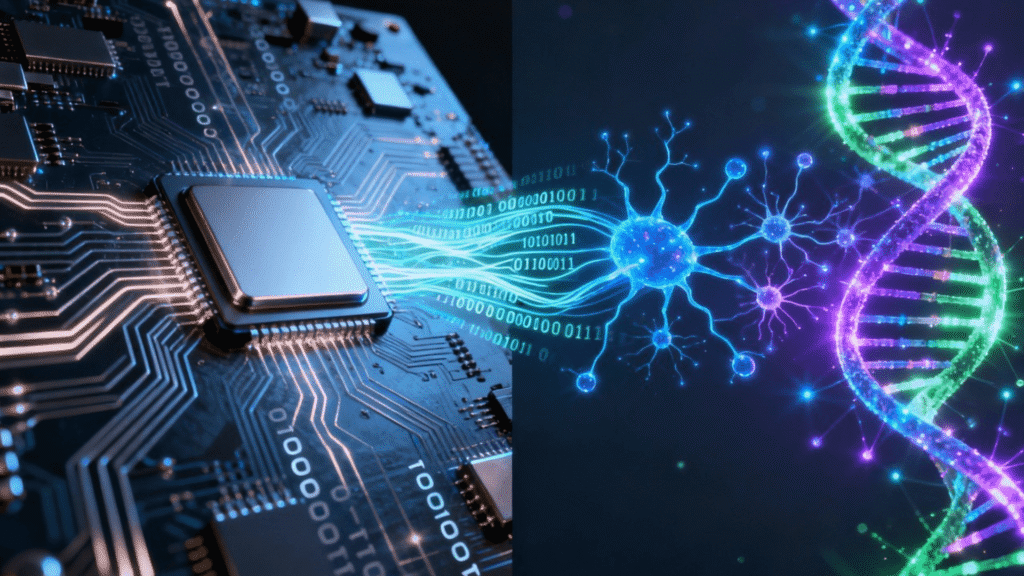
DNA storage is the real MVP. Imagine cramming your entire Spotify library, the Library of Congress, and all those embarrassing photos you swore you deleted from middle school onto a speck of DNA smaller than a crumb. Seriously—one gram of DNA can hoard, what, 200 petabytes? That’s so much space, you couldn’t fill it if you tried, even if you lived to be a hundred. Your grandkids will probably still be finding room for their weird hologram TikToks.
But hold up, DNA storage is basically just a supercharged thumb drive—just sitting there, chillin’, hoarding your data. Organoid Intelligence (OI)? Now you’re in the wild zone. Instead of just hoarding info, OI actually thinks. Like, in real time. It’s powered by neurons, which, let’s be honest, have been crushing the thinking game since before dinosaurs were a thing. OI isn’t just another shiny gadget—it’s a total paradigm shift. Imagine tossing out your clunky metal computers and swapping in squishy blobs of mini-brains that learn and adapt as they work. Sounds kinda gross? Maybe. But also? Completely rad.
Enter the “Mini-Brains”: What Exactly is Organoid Intelligence (OI)?
Here’s where it gets seriously trippy. Organoid Intelligence is all about brain organoids. But don’t get it twisted—a brain organoid is not a tiny, sentient head floating in a jar. No one’s building little Frankensteins (yet). It’s more like a “brain starter pack.”
Scientists basically cook these things up from stem cells—usually snagged from your skin or blood, nothing too fancy. Stem cells are, like, the Swiss Army knives of biology. You nudge them the right way, and boom, they can morph into pretty much any cell you need. In the lab, scientists toss in some chemicals, sprinkle a little scientific chaos, and suddenly you’ve got these cells turning into neurons, astrocytes—basically the whole neural squad. Next thing you know, they’re self-assembling into these weird, jiggly blobs that act suspiciously like a baby brain—firing off signals, linking up, even cranking out those adorable baby brain waves.
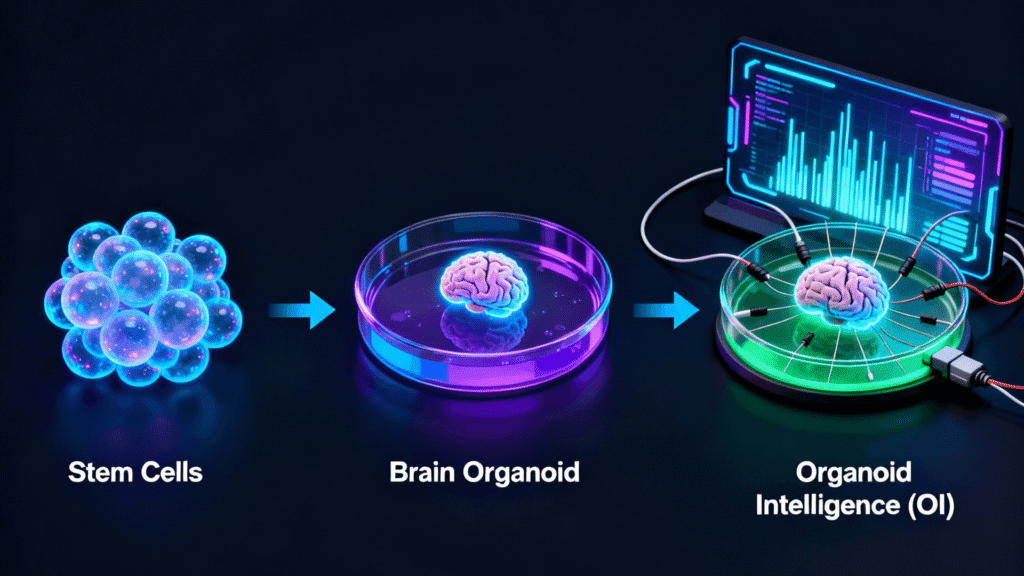
And the so-called “intelligence” part? That’s where things get straight-up sci-fi. Researchers slap these mini-brains onto something called a microelectrode array—imagine a petri dish with a serious upgrade, covered in tiny sensors. These things can zap the organoid with signals and eavesdrop on the electrical gossip coming back. It’s a feedback loop: you prod the blob with data, it responds, you scoop up the results. Boom, you’ve got yourself a living, kinda-sorta thinking biological processor. Just a tiny brain blob, chilling next to your computer. Science these days is absolutely bonkers.
The “DishBrain”: How Scientists Taught Brain Cells to Play Pong
Alright, so here’s the wild part that really put Organoid Intelligence on everyone’s radar: this totally bonkers experiment by Cortical Labs in 2022. These folks actually grew around 800,000 human brain cells on a microelectrode array. Like, imagine a tiny Petri dish with a bunch of brain goo deciding to have a go at retro gaming. They called it “DishBrain” because, well, what else are you gonna name a dish full of neurons?
To get these cells to play Pong (yeah, that Pong), the researchers translated the game’s info into electrical zaps. Electrodes on one edge of the dish would buzz to tell the cells, “Hey, here’s where the ball is!” The closer the ball got, the faster the zaps. The brain blobs’ job? Shoot back some neuron signals to move the paddle up or down. Simple, right? Not really.
But here’s the kicker: it wasn’t just a mindless reaction. The real genius was in how they got the cells to learn. They used this thing called the “free energy principle,” which is basically a fancy way of saying that life likes things predictable. So, when the cells did the right thing—paddle hits ball—they got a nice, predictable electrical signal. When they screwed up? Boom, hit with pure chaos: messy, unpredictable “white noise.” Nobody likes that.
Fonte: AI Revolution
And guess what? The cells started getting the hang of it. Over time, DishBrain kept the rallies going longer and actually got better at Pong—like, you could see it learning, not just reacting. The neurons were literally rewiring themselves to keep things as chill and predictable as possible. That’s not just input-output—this is actual goal-directed learning happening in a dish. Wild, right? (Source: Neuron)
The Ultimate Showdown: Organoid Intelligence vs. Digital AI
So, why go through all the trouble of growing tiny brain blobs when we’ve got digital titans like GPT-4 or those room-sized supercomputers? Well, there’s a few reasons, and they’re kinda awesome.
First off, energy. The human brain is basically the Tesla of computing—super-efficient. It crunches out about 1 exaflop (that’s a billion billion calculations per second, by the way) using just 20 watts. That’s less than your sad desk lamp. Now look at Frontier, one of the biggest, baddest supercomputers out there: it gulps down 21 million watts to hit the same numbers. That’s… not exactly eco-friendly. Data centers that run big AIs? Energy hogs. Like, “let’s black out a small town” levels of power.
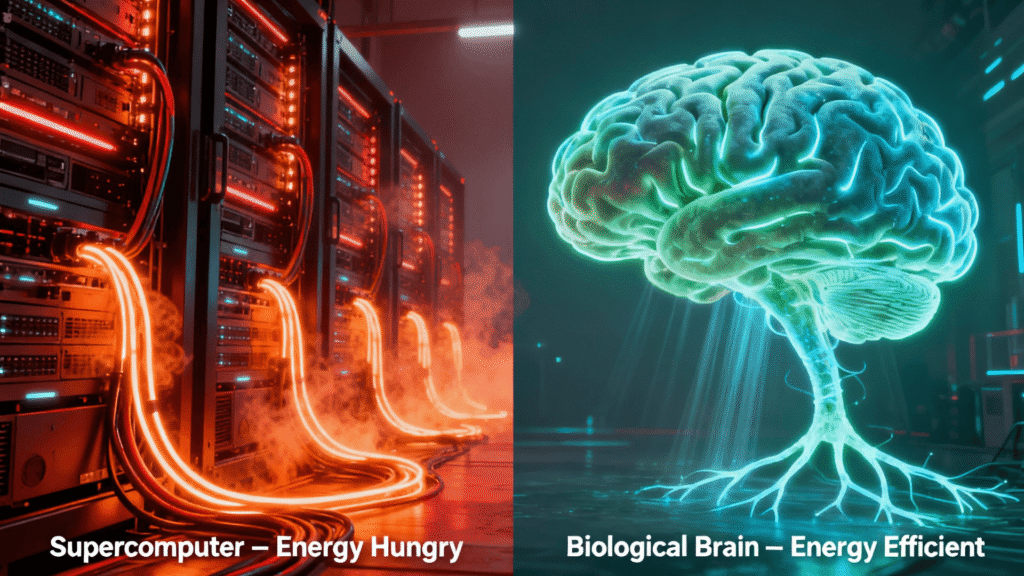
Next, learning style. Digital AIs need to gorge themselves on massive datasets—think thousands of hours of training and a warehouse full of GPUs just to get up to speed. It’s a two-step process: train forever, then use what you learned. Meanwhile, our DishBrain? Picked up Pong in five minutes flat. No joke. Biological neurons learn as they go—no endless training marathons, just real-time, “let’s figure this out now” action. Way more efficient with data, way less drama. So yeah, organoid intelligence isn’t just some weird science flex—it’s showing up digital AI in a few serious ways. And honestly? I’m here for it.
“Wetware” vs. “Hardware”: Look, the guts of a brain and a computer don’t even play the same sport. Your average digital computer? It’s locked into this old-school Von Neumann scheme—memory over here, processing way over there, and they’re constantly sending stuff back and forth. It’s like having a kitchen and a pantry on opposite sides of the house. Super inefficient. That’s the bottleneck right there. But your brain? Or these wild little brain organoids? They keep memory and processing tangled up together in the same neural mush. It’s all happening in one spot. That’s what folks mean by “in-memory computing.” No wonder our brains beat computers at certain things—they’re just built differently. That’s “wetware” for you, a whole different beast compared to the cold, hard “hardware” in your laptop. (Source: Frontiers in Science)
| Feature | Digital AI (like GPT-4) | Organoid Intelligence (OI) |
|---|---|---|
| Power Consumption | Megawatts (for training) | Watts (yeah, just watts!) |
| Data Needs | Massive (Petabytes) | Low, more of a trickle |
| Learning Style | Offline, batch style | Online, learns on the fly |
| Architecture | Hardware (Silicon) | Wetware (Biological) |
| Flexibility | Pretty specialized | Can roll with anything |
So, What’s The Point? Real-World Applications of OI
Dude, Organoid Intelligence is wild—like, it sounds ripped straight out of a Black Mirror episode or something. No joke, if this stuff actually takes off, medicine’s gonna get a hardcore upgrade. Imagine, some scientist is in the back, whipping up a little brain clone from your own cells—maybe your grandma’s losing her memory, or your uncle’s hands won’t stop shaking, or your little cousin’s on the spectrum. Instead of just throwing random pills at them and crossing their fingers, they just dump whatever drug they wanna test right onto these baby brains and see what happens. It’s basically science hacking in real time. Suddenly, drug testing isn’t some endless snail race—it’s like hitting fast-forward on everything. Maybe, finally, doctors quit handing everyone the same prescription like it’s Halloween candy. Honestly, it blows my mind.
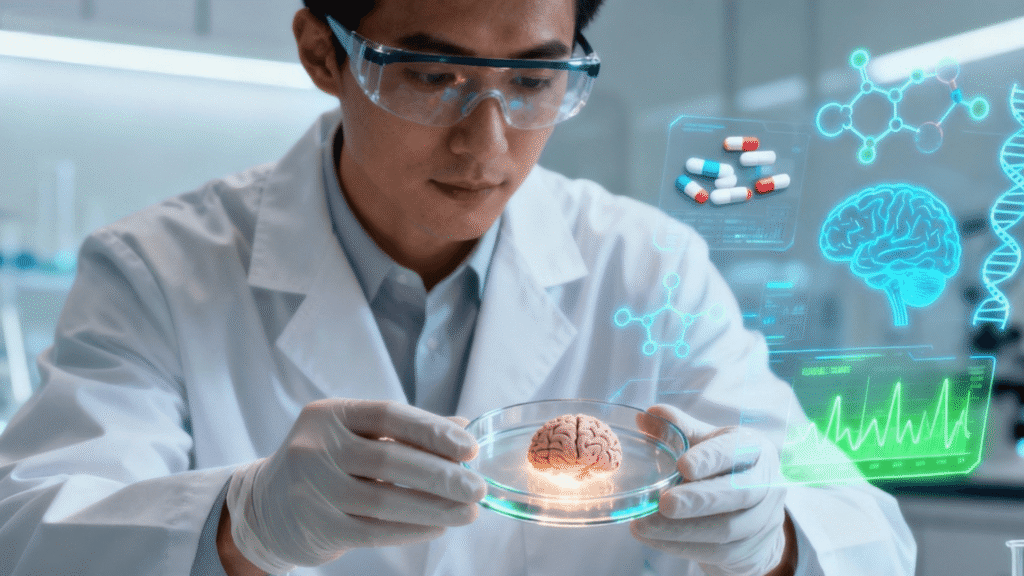
And then there’s AI. Don’t get me wrong, AI’s cool and all, but it’s got the common sense of a soggy cardboard box. It can spot patterns like nobody’s business, but ask it to actually understand what’s going on? Good luck. That’s where brain organoids come in. By poking around in how these little blobs learn, scientists might finally crack the code on what makes biological smarts tick. Copy those tricks, and boom—maybe we finally get AI that doesn’t just pretend to get things, but actually thinks (well, sorta). That’s inching us closer to the sci-fi dream—actual Artificial General Intelligence. Or, you know, Skynet, if things get spicy.
Is silicon about to be fired? Okay, the excitement will pass quickly—just imagine: instead of computers rolling off an assembly line, we’re literally developing them in labs. Yep, you heard me. Not just “built,” but “grown,” like natural yeast or a weird science project gone wrong. These bioprocessors—if we ever pull it off—could blow today’s silicon chips outta the water. They’d be crazy powerful, sip electricity instead of guzzling it, and, get this, they’d actually get smarter the more you use them. Forget tossing your phone every two years. With this sci-fi stuff, your phone could basically go Super Saiyan just by hanging out with you. Sounds nuts, right? We’re nowhere close yet, but that’s the North Star everyone in this field is chasing.
The Elephant in the Room: Could a “Mini-Brain” Become Conscious?
Now, here’s where things get sticky. Growing chunks of human brain in a dish? Sure, it sounds like the next season of Black Mirror, but it’s real. And it freaks people out, for good reason. What if these organoids—these mini-brains—start feeling stuff or, I dunno, start wondering why they’re stuck in a jar? That’s a whole new can of ethical worms.
Scientists aren’t just shrugging this off. Over at Johns Hopkins, the big brains (heh) are actually teaming up with bioethicists, writing up rulebooks, and trying to keep things transparent. Their idea is pretty chill: keep everything tightly regulated and make sure everyone’s watching what’s going on.
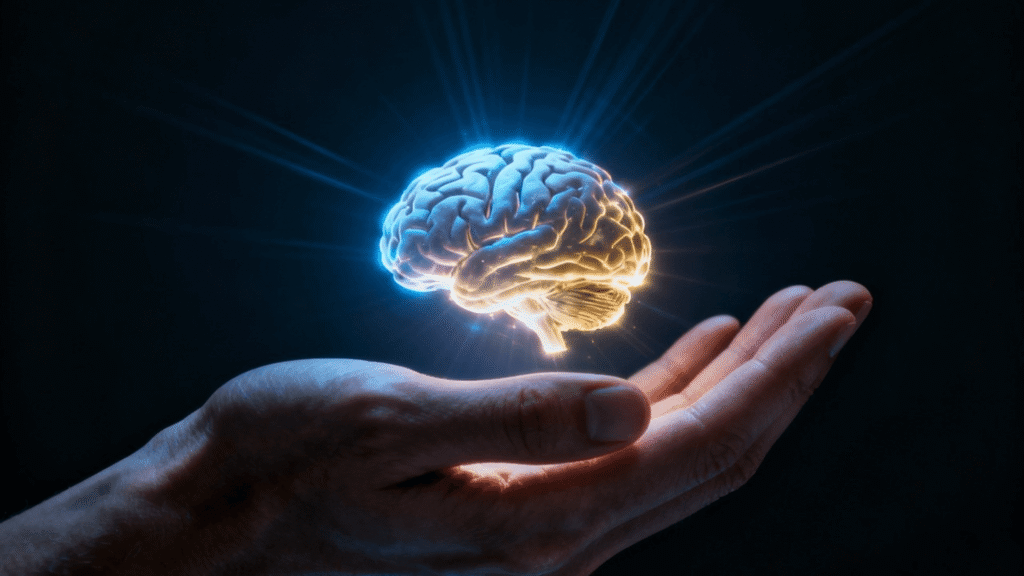
Right now, the consensus is: nah, these organoids aren’t anywhere close to being conscious. They’re missing way too many pieces—no full structure, no real senses, nada. But if something weird pops up, like brainwaves that start looking a little too human? They’ll slam the brakes. No one wants to accidentally create a tiny, sentient blob. So, yeah, they’re keeping it on a tight leash. (Source: Johns Hopkins University)
Conclusion: The Dawn of Biological Computing
Here’s the thing—Organoid Intelligence isn’t some random science sideshow. It’s a legit game-changer. We’re not just copying how brains work with fancy chips; we’re actually using real living cells to process info. That’s bonkers. The possibilities? Insane. Super-efficient computers, deeper clues about how our own brains tick, maybe even a shot at curing brain diseases that have stumped us for decades. The future’s looking less like The Matrix and more like Frankenstein meets Apple, and honestly, I’m here for it.
Alright, let’s cut through the sci-fi haze—this whole organoid intelligence thing? We’re still at the baby steps stage. Scaling up those “mini-brains,” making the tech less Frankenstein-y, and wading through the ethical quicksand—none of that’s easy. But if you think about how the first clunky transistors led to everyone basically carrying a supercomputer in their jeans, brain cells playing Pong might be the first “what the heck?” glimpse into a future where digital, quantum, and biological smarts all just blur together.
When will I have a brain blob powering my phone?
Don’t hold your breath. The tech’s still wearing diapers. For the next decade, it’s all about research and maybe medical breakthroughs—not cramming a gooey processor into your iPhone. Regular folks probably won’t see this stuff hit Best Buy shelves for ages, if ever.
Wait, is this even safe? What if they get smart or… escape?
Relax, it’s not The Blob. These cell clusters aren’t breaking out of the lab or becoming little Einsteins overnight. The real worry is more philosophical: could they feel pain or become “conscious”? That’s the big debate, and there are ethics nerds and scientists setting up strict rules to keep things in check.
How’s Organoid Intelligence different from Neuralink?
Totally different ball games. Neuralink’s all about wiring up your actual brain to computers—think USB port for your noggin. Organoid Intelligence, though, is building a teeny-tiny brain from scratch, outside of any body, and using that as a kind of living processor. One plugs into your head, the other sits in a petri dish.
Where do the brain cells even come from? Is this some Frankenstein stuff?
Most of the time, the cells come from “induced pluripotent stem cells”—which is science-speak for adult skin or blood cells that get reprogrammed back to a stem cell state. The rules around this are super strict—nobody’s just winging it.
Could OI help us hit AGI sooner?
Honestly, yeah, it’s definitely on the table. A huge part of what’s holding us back from AGI is that we’re still kinda clueless about how brains actually learn stuff. If scientists mess around with organoids and watch them figure things out, we might finally crack some of the brain’s secret code. It’s like copying someone’s homework, but with neurons.
Want to Stay Ahead of the Curve?
Our newsletter is coming soon. In the meantime, continue your journey into the future of technology.
» Explore Our Guide on OpenUSD, the Tech Building the 3D Internet «







